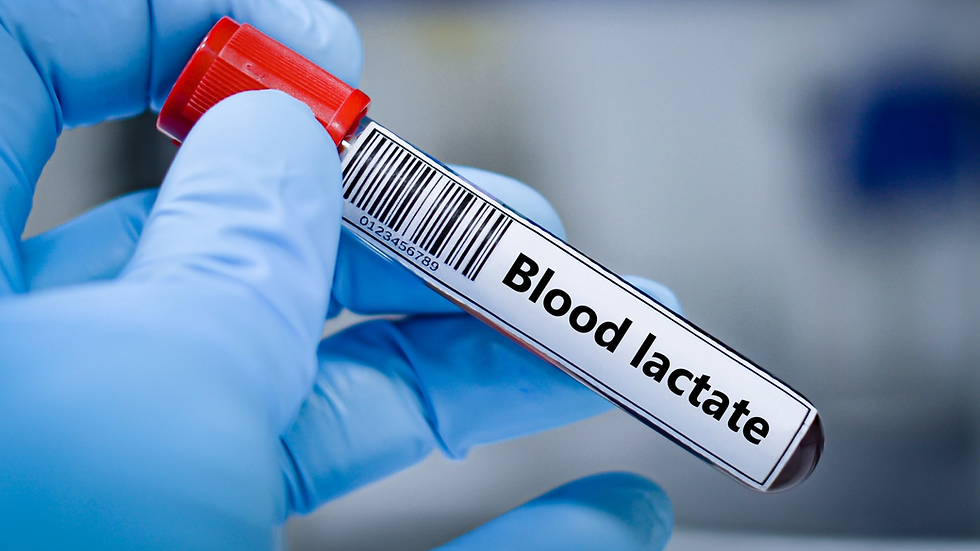REPEATED SPRINT ABILITY (RSA) CYCLE TEST
- Moran Sciamama-Saghiv
- Sep 3
- 5 min read
The RSA Cycling Test is a vital assessment for cyclists, designed to measure their physical capabilities and endurance. Whether you're an experienced cyclist or a beginner eager to enhance your performance, grasping the RSA Cycling Test will help you set practical goals and track your progress. In this post, we will discuss the purpose of the RSA Cycling Test, the procedure for conducting it, and practical tips for preparation.
What is the RSA Cycling Test?
The RSA Cycling Test, also known as the Ramp Step Test, is a standardized method to assess a cyclist's aerobic capacity and overall fitness. This evaluation is favored by athletes and fitness enthusiasts aiming to track their performance and find areas for growth.
During the test, participants cycle on a stationary bike, gradually increasing the resistance until they reach the point of exhaustion. This method measures your maximum oxygen uptake (VO2 max), a crucial indicator of cardiovascular fitness. For instance, elite cyclists often aim for a VO2 max of 70-80 mL/kg/min, while average recreational cyclists may have a VO2 max closer to 40-50 mL/kg/min.
Why is the RSA Cycling Test Important?
Understanding your fitness level is vital for every cyclist. The RSA Cycling Test offers insightful data about your aerobic capacity, which helps you to:
Set Realistic Goals: Knowing your current fitness level enables you to create attainable targets. For example, if your VO2 max is below average, aiming for a 10% improvement over a few months can be a realistic goal.
Track Progress: Regular testing allows you to monitor changes and improvements over time. Studies suggest that consistent testing can show a 5-10% increase in VO2 max for dedicated individuals over several months.
Tailor Training Programs: The test results guide your training plan, focusing on areas that need improvement. If your VO2 max is low, including more interval training can help boost your endurance.
Prevent Injury: Recognizing your limits helps prevent overtraining and lowers the risk of injury. Approximately 65% of cyclists experience injuries due to unbalanced training regimens.
How is the RSA Cycling Test Conducted?
Typically performed in a controlled setting, such as a gym or a sports facility, the RSA Cycling Test follows specific steps:
Step 1: Preparation
Before the test, ensure you are well-hydrated and consume a light meal. Wearing comfortable clothing and cycling shoes can also enhance your testing experience.
Step 2: Warm-Up
Start with a 5-10 minute warm-up at a low intensity. This prepares your muscles and cardiovascular system for the test.
Step 3: Begin the Test
Set Up the Bike: Adjust the bike to suit your height and comfort level.
Start Cycling: Begin at a low resistance and increase it gradually.
Increase Resistance: Every few minutes, ramp up the resistance to challenge yourself.
Monitor Heart Rate: Track your heart rate steadily throughout the test.
Push to Exhaustion: Continue increasing the resistance until you cannot maintain the effort.
Step 4: Cool Down
After reaching exhaustion, gradually decrease the resistance and cycle at a low intensity for 5-10 minutes to cool down.
Step 5: Analyze Results
Your VO2 max will be calculated based on your performance. This measurement will provide insights into your aerobic capacity and help inform your training.

Preparing for the RSA Cycling Test
Preparation is key for achieving the best results in the RSA Cycling Test. Consider these practical tips:
Build a Solid Base
Ensure you have a strong foundation of cycling fitness before attempting the test. Regular cycling workouts should include both endurance rides and interval training to build your base.
Focus on Nutrition
Proper nutrition is crucial for performance. Eating a balanced diet rich in carbohydrates, proteins, and healthy fats is essential. On test day, opt for a light meal that gives you energy without weighing you down—think oatmeal with fruit or a banana with nut butter.
Stay Hydrated
Hydration significantly impacts performance. Aim to drink half your body weight in ounces of water per day in the days leading up to the test. On test day, consume water or an electrolyte drink before the evaluation.
Get Adequate Rest
Quality rest is essential. Aim for 7-9 hours of sleep the night before the test to ensure your body is well-prepared for the effort.
Practice Mental Preparation
Visualizing success can positively influence your performance. Spend a few minutes each day picturing yourself completing the test and accomplishing your goals.
Interpreting Your Results
After completing the RSA Cycling Test, it's vital to understand the implications of your results. Your VO2 max score typically falls into these categories:
Excellent: Signifies a high level of cardiovascular fitness.
Good: Reflects a solid fitness level with room for growth.
Average: Suggests moderate fitness, indicating a need for more training.
Below Average: Signals the need for enhancements to your aerobic capacity.
Knowing your standing can help tailor your training program to target specific improvement areas.

Training Tips to Improve Your RSA Cycling Test Results
To enhance your performance in the RSA Cycling Test, consider these structured training recommendations:
Incorporate Interval Training
Interval training engages you in alternating high-intensity efforts with recovery periods. This method can boost your aerobic capacity and overall cycling performance. Research shows that incorporating intervals can increase VO2 max by 20% in as little as six weeks.
Focus on Endurance Rides
Long, steady rides at a moderate pace help strengthen your aerobic base. Aim for one long ride per week, gradually building up to at least 2-3 hours of cycling.
Strength Training
Including strength training can improve your cycling power. Focusing on key exercises, such as squats and deadlifts, enhances muscle strength, making you more efficient on the bike.
Monitor Your Progress
Keep a journal of your training sessions and test results. Tracking your improvements helps identify trends and allows you to adjust your training accordingly.
Rest and Recovery
Prioritize recovery as much as activity. Allow adequate time for your body to heal between intense workouts to avoid burnout and injury.
Common Mistakes to Avoid
As you prepare for the RSA Cycling Test, avoid these common mistakes that can undermine your performance:
Skipping Warm-Up
Neglecting your warm-up can lead to injuries and hamper performance. Always ensure you perform a warm-up before the test.
Overtraining
Pushing too hard can cause fatigue and burnout. Listen to your body and ensure you are allowing sufficient recovery time between workouts.
Ignoring Nutrition
Poor nutrition can drain your energy and affect performance. Fuel your body appropriately to optimize your results.
Not Setting Goals
Without clear goals, staying motivated can be challenging. Set specific, measurable, achievable, relevant, and time-bound (SMART) goals for your training.
Underestimating Mental Preparation
Mental readiness is equally important as physical training. Engage in positive visualization and self-talk to enhance your testing experience.

Final Thoughts
The RSA Cycling Test is a powerful tool for cyclists aiming to assess their fitness and enhance their performance. By understanding the test, preparing effectively, and following a structured training plan, you can improve your aerobic capacity and work towards your cycling goals. Regularly monitoring your progress keeps motivation high and helps you stay focused on achieving better performance.
With commitment and the right strategies, remarkable advancements in your cycling ability are within reach. Enjoy your journey to becoming a better cyclist!
Services by Dr. Moran Sciamama-Saghiv:





Comments